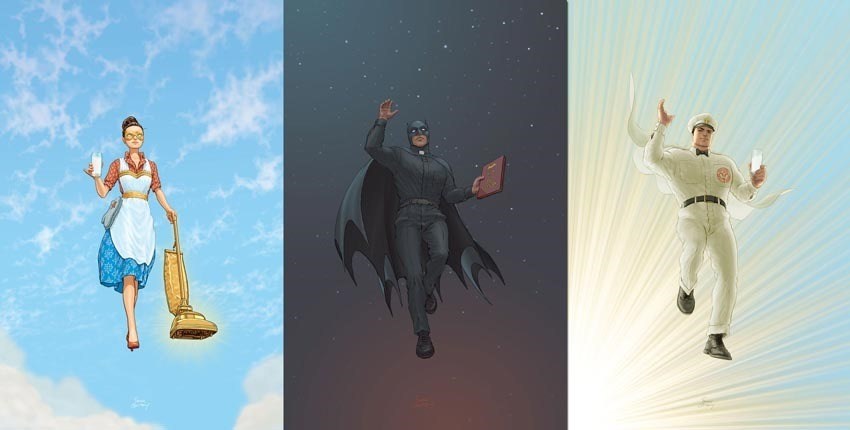
Shade, The Changing Girl/Wonder Woman Special #1
Writer: Cecil Castellucci
Artist: Mirka Andolfo
Colorist: Marissa Louise
Letterer: Saida Temofonte
Publisher: DC’s Young Animal
Review by Anelise Farris

Shade, The Changing Girl/Wonder Woman Special #1 is part three of “Milk Wars.” If you are familiar with Shade, then you know that she already has a multiplicitous identity, but here Shade is literally divided into multiple parts. Each part represents a different mood: red-dressed Shade represents anger, pink-dressed Shade embodies love, and yellow-dressed Shade is happiness, to name a few.
This emotional task force serves Wonder Wife: Wonder Woman who is no longer the Amazonian goddess but rather a spa-loving, Bupperwear-addicted, vacuuming-expert that embraces all things domesticity. Initially, everything in Shade, The Changing Girl/Wonder Woman Special #1 seems ideal—like giant hot tub ideal, literally. However, fairly quickly the various Shades begin to realize that all is not right in the world. The individual Shades begin to question what they’re feeling, and Happiness makes it her mission to set things right and restore Wonder Wife to her former glory.
There’s a political tone to Shade, The Changing Girl/Wonder Woman Special #1, as it takes us to a women’s rally, and Wonder Wife is continually questioning/being asked if there is more than domestic aspirations for a woman. Although at times it seemed to be a bit heavy handed in disparaging women that might choose a domestic rather than professional life, one of the last lines did a nice job of connecting women rather than separating them: “Every woman plus every woman equals wonder woman.” Just like every woman comes together to make a wonder woman, the “message” here (as much as I hate that approach) seems to be that feeling everything—though not always pleasant—is a better option than hiding or neglecting certain emotions.
The art was quite different from traditional Shade, the Changing Girl style. The stiff, more traditional cartoon-style art had trouble holding up to the trippyness of the story that was being told. And, although the pastel colors and line-play in the latter half of the comic did work better, the overwhelming inconsistency just rendered it busy rather than gratifying. Similarly, the panel arrangements in Shade, The Changing Girl/Wonder Woman Special #1 were nonsensical and unnecessary at times.
Verdict: Check it out.
Shade, The Changing Girl/Wonder Woman Special #1 has a heavy moralizing tone and erratic, lackluster art, but that doesn’t mean it’s not an enjoyable read—just know what you’re getting into. There are some terrific lines concerning poetry and some humorous bits about Bupperwear and feelings.
“Milk Wars” will be concluded in Doom Patrol/Justice League of America.

![[REVIEW] THERE’S A STARMAN WAITING IN ‘BOWIE: STARDUST, RAYGUNS & MOONAGE DAYDREAMS’](https://geekd-out.com/wp-content/uploads/2020/01/81CkFLC2T1asgdasdL-150x150.jpg)


The first two installments of “Milk Wars” have me equal parts confused and intrigued. I’ll give this one a shot, mostly because I love Wonder Woman and I’m curious about Shade.